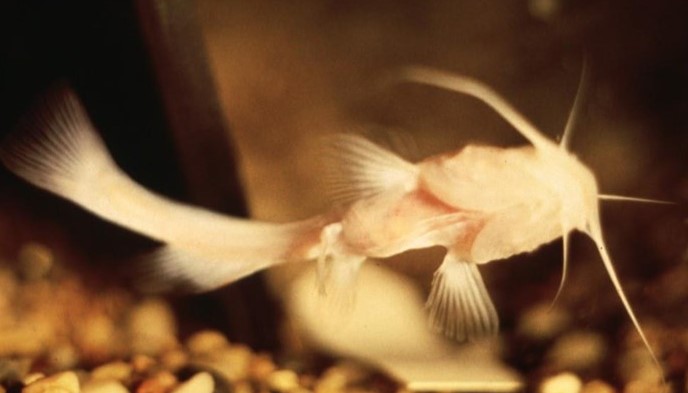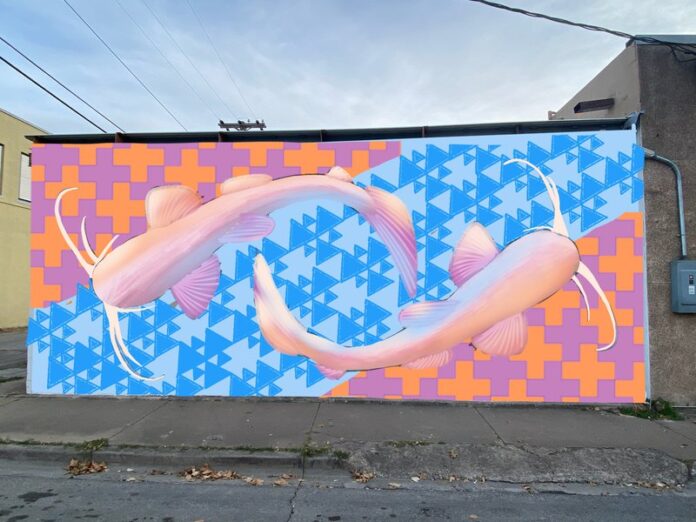The Center for Biological Diversity and Del Rio’s Casa de la Cultura will host a community event Oct.16 to celebrate a new mural of the Mexican blindcat, an endangered catfish found in underground aquifers on both sides of the U.S.-Mexico border in south Texas and northern Coahuila. The 25-square foot painting will be the latest installment in the Center’s national endangered species mural project, which highlights imperiled plants and animals that are special to their regions.
Who: The celebration will feature artist Roger Peet, who coordinates the Center’s mural project; Lupita de la Paz, executive director of Del Rio’s Casa de la Cultura; Sarah Howard, National Park Service biologist at Amistad National Recreation Area; and Andy Gluesenkamp, director of conservation at the San Antonio Zoo. Community members are invited to help paint from 12-5 p.m. today and Oct. 12 and 13, leading up to the celebration on Oct. 16.
What: Free community mural celebration with live music and refreshments. Vaccines, masks, and social distancing encouraged.
Where: 100 E Losoya Street, Del Rio, Texas 78840
When: Saturday Oct. 16, 5:30 p.m. CT
Project Quotes
“It’s exciting to have the opportunity to paint a mural of this elusive and fascinating animal, whose subterranean cross-border existence really shows how arbitrary the lines are that we draw to divide ourselves against each other,” said artist Roger Peet.
“We’re super excited to be a part of this project. Not only is it bringing beautification to our downtown neighborhood, but providing knowledge, which is something that we can never take from those who are willing to learn. We are looking forward to passing by this street and having the reminder of how important art and preservations are,” said Lupita de la Paz, executive director of Casa de la Cultura, a community organization that works to make arts and literacy accessible and affordable.
“Ending extinction, fighting for social justice and keeping a livable climate all have shared causes and solutions,” said Tierra Curry, a senior scientist at the Center for Biological Diversity. “Our mural project connects communities to highlight that the wellbeing of humans and wildlife are intertwined, and that all the fights for justice need to be simultaneous and urgent.”
Mural Project Background
The Center’s endangered species mural project has now installed more than 20 murals including a jaguar in Tucson, Arizona; a Mexican wolf in El Paso, Texas; Austin blind salamanders in Austin, Texas; an aplomado falcon in Ciudad Juarez, Chihuahua, Mexico; and monarch butterflies in Minneapolis, Minnesota.
The project is spearheaded by Portland, Oregon artist Roger Peet, who teams up with local artists and community groups to bring larger-than-life endangered species to public spaces to increase appreciation for the regional biodiversity that makes places special. The project aims to celebrate local endangered species and encourage people to make connections between conservation and community strength.

Species Background
Mexican blindcats are catfishes who live only in groundwater up to 2,000 feet underground in the Edwards-Trinity Aquifer underlying the Rio Grande Basin in Texas and Coahuila, Mexico. They grow to be about five inches long and look pinkish due to translucent skin that allows their blood vessels to show through.
The blindcat’s snout overhangs its mouth, which, along with the fish’s sharp sense of smell, helps them hunt for macroinvertebrates. Their lateral lines help them detect motion in the water. Blindcats will swallow any small prey they come across, though they can survive long periods without eating.
While most people will never see these fish, they are important because their health reflects the health of the groundwater where they live. Humans are completely dependent on the groundwater supply for drinking water and other uses.
Once thought to only live in Mexico, the discovery of the Mexican blindcat in Texas in 2015 shows that the watershed is connected across the border and reflects the connection of human and natural communities between the two countries. The blindcat was protected under the U.S. Endangered Species Act in Mexico in 1970 and is now also protected in the United States.
The biggest threats to the blindcat’s survival are overuse of groundwater and pollution. Rock layers in the Edwards-Trinity Aquifer are highly porous, and the water is vulnerable to contamination from agriculture, development and fossil fuel extraction.
The San Antonio Zoo’s Department of Conservation and Research houses some Mexican blindcats in a special area for cave and aquifer species. This area is closed to the public in the hopes of establishing a captive-breeding population to ensure the species is not lost to extinction.
Source: biologicaldiversity.org






